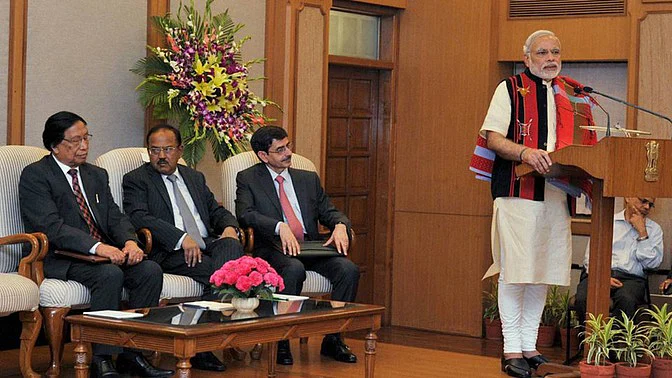- The NSCN(IM)‘s initial demands were kept on the back burner while the Government of India continued to persuade them to reach an agreement
- An agreement was reached in 2007 where the government recognised the unique history and situation of the Nagas
- One reason for the NSCN(IM) to have asked for a reorganised Nagalim may have been the fact that the Nagas in neighbouring States do not enjoy the same protection given by the Constitution to the Nagas in Nagaland
- There are various difficulties that stand in the way of a peaceful Accord with the Nagas, inter-factional armed conflicts being one
- But ultimately, there are also several positive factors that indicate that an Accord has a good chance of success – all of which are listed out below
NSCN(IM) started negotiations with a demand for an independent Nagaland (Nagalim), while simultaneously incorporating the Naga inhabited areas in the adjoining States.
But over the course of protracted negotiations they were told that the government could not accept these proposals. The realisation soon dawned upon the NSCN(IM) that these goals were impossible of achievement; these were subsequently kept on the back burner, as the government persuaded them that the Indian Constitution was, in fact, a flexible document, that it has accommodated the unique nature of various other States in India, and that it can provide for almost all the aspirations of the Nagas.
In November 2004, NSCN(IM) leaders were persuaded to visit India, where they stayed – in Delhi – for 8 months. This was the time when the GoM on Nagaland held extensive discussions with Muivah and his team.
When the Government of India Embraced the Unique History of the Nagas
Mr. Muivah came back to India once again in March 2007 and stayed back. After many sessions of discussions NSCN(IM) leaders, jointly with the government team, studied the Indian Constitution fairly thoroughly and agreed for a possible agreement within the framework of the Indian Constitution.
This agreement though was conditional upon the Government of India recognising the unique history and situation of the Nagas, and further agreeing to reexamine the distribution of legislative and executive powers to Nagaland, in order to sustain their distinct identity and development in consonance with their own genius.
With the approval of the government, a joint communiqué was signed with NSCN(IM) in July 2002, in which the Government of India recognised the unique history and situation of the Nagas and stated that talks should proceed in a forward looking manner.
A Possible Grouse: Nagas in Neighbouring States Not at Par With Nagas in Nagaland
Press reports indicate that the Government’s recognition of the unique history and situation of the Nagas (which it had agreed to at the time) is the foundation of the present accord.
A second major point the NSCN(IM) had argued during talks earlier was that Nagas in the neighbouring States do not enjoy the protection given by the Constitution to the Nagas in Nagaland. This may be one of the reasons which propelled them to seek a re-organised Nagalim.
A possible solution that has been suggested to them, is the creation of a Naga Regional Council – comprising representatives from all major Naga tribes in the North East – which should be consulted by the concerned State governments on matters relating to the socio-economic development of Naga tribes living in those States.
But this would require convincing the States concerned that an accord with Nagas would not only help the Nagas, but would bring peace to the entire region and be a great boon to the region.
The Road to a Peace Accord: Difficulties and the Glimmerings of Hope
All these factors, namely – the difficulties in maintaining peace in the face of inter factional armed conflicts, the difficulties in involving main armed factions in the process of finalising the Accord, involving the State government, all insurgent groups and civil society organisations as signatories to the Accord, the response of the Governments of concerned neighbouring States – need to be addressed.
But there are several positive factors that indicate that an Accord has a good chance of success. For instance, over the last decade most armed cadres have come out of the jungles and have settled down to a stable life. Naga areas have enjoyed a peace dividend for 18 long years (except for internecine factional clashes). There is a vibrant civil society in Nagaland which would actively work to preserve this peace by all concerned, while the north east, as a whole, is also on the anvil of sustained growth and development as a result of focus on Act East policy.
The fact that the leadership of the NSCN(IM) has matured exponentially has also been a positive factor – but most important is the fact that in the last few years there has been a greater degree of interaction and integration of youth from Nagaland and other NE States with the rest of the country, and that not only the Nagas but the entire north east is longing for lasting peace in the region.
(A former Union Home Secretary, K Padmanabhaiah was the Centre’s interlocutor for the Naga peace talks between 1999 and 2009. This is the last piece of a three-part series by the author. Read the first part here)
